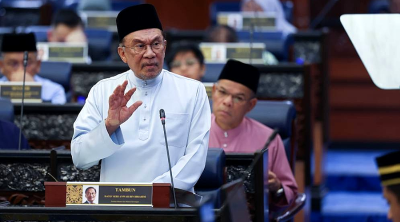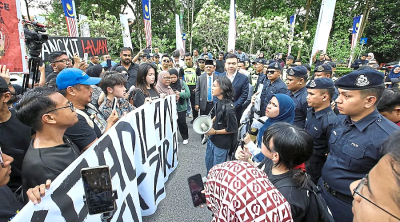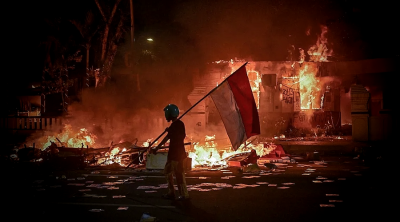
This is the first time that Malaysia has seen such a large-scale civil rights action, the first of its kind in Malaysia.
Tens of thousands of Sabahans took to the streets of Sandakan, Tawau, and Lahad Datu of their own accord to demand justice for a young girl named Zara Qairina Mahathir.
People held up banners and chanted, “Justice for Zara!”
They even composed a sorrowful song about Zara that is being sung all over Sabah.
Thirteen-year-old Zara was a student at a religious boarding school. To her parents, teachers, and classmates, she was a well-behaved student.
However, on July 16, she was found unconscious after a fall from her dormitory building. She was taken to the hospital but died from her injuries.
The initial police report stated that Zara fell from the third floor of the dorm and that there was nothing suspicious about the case. The school did not conduct an investigation and the principal even told Zara’s mother not to pursue the matter.
But the case was not that simple.
Zara’s mother claimed that Zara had repeatedly complained to her that older students at the school were bullying her and that she was afraid to go to school.
A classmate of Zara also claimed that before the fall, they saw Zara huddled in a corner, seemingly injured. Another student reported hearing a commotion.
Zara’s family also found many wounds, bruises, and swelling on her body, which were unusual.
However, the police did not take further action or perform an autopsy.
Zara’s mother didn’t give up. She provided the police with a voice recording of Zara’s phone call where she claimed she was being bullied and collected information on other students who had been bullied. She also hired a lawyer to request that authorities reopen the investigation and apply for an exhumation and autopsy.
The Attorney-General’s Chambers re-examined the case, returned the original Zara case report to the Sabah police, and ordered an exhumation and autopsy.
The next day, protest rallies appeared in various towns across Sabah to support Zara’s family and demand justice for her.
Why has the Zara incident attracted so much attention, even leading to street protests?
The reason is that Zara’s death has too many unanswered questions while the school, police and Ministry of Education have not handled them appropriately.
People are aware of the school’s bullying record, but the police did not conduct a thorough investigation. Despite the wounds and bruises on her body, the police didn’t perform an autopsy. Rumours are also rampant that Zara was put in a large washing machine, soaked in water, and spun in the drum.
The school adopted a “peace-at-all-costs” attitude. While students and parents named several students suspected of bullying Zara and provided a list of habitual bullies, the school did not take action.
As for the Ministry of Education, its typical response was to leave the matter to the police. The Minister of Education, Fadhlina Sidek, even warned the public not to spread “rumours.”
These responses disappointed and disheartened Zara’s relatives and the people of Sabah. They cannot let Zara die an unjust death, and they don’t want their children to live in such torment and fear.
When the Ministry of Education and the police failed to bring Zara justice, the public had no choice but to take matters into their own hands.
Many rumours also claim that the bullies are the children of powerful people and that the school leadership has connections with senior politicians.
These rumours have not been confirmed, and their authenticity is unknown. However, the inaction of the police and school authorities has strengthened people’s suspicions that the perpetrators have powerful backers, which is why the school and police were so quick to sweep the case under the rug.
This also reflects the current social class conflict. The rich and the poor, the powerful and the powerless, live in opposing worlds. The vulnerable feel that they are being treated unfairly and cannot get protection from the administration (the government and police) and the judiciary (the courts), so they take to the streets to seek justice for themselves.
Tens of thousands of Sabahans took to the streets to protest, including many mothers who usually only handle household chores. This time, they also protested with tears in their eyes, out of sympathy and as a cry from the vulnerable.
The facts at hand are the irresponsibility and haste of the police in handling this case. With so many suspicious details—from the background, motive, wounds, and personal belongings—that could have gone uninvestigated and unaddressed, where is the professionalism and competence?
This kind of incompetence is not rare. In the case of Ivana Esther Robert Smit, a Dutch model who died after a fall in Kuala Lumpur, the victim’s family sued the Malaysian police and government for negligence, including improper handling of evidence, mishandling of witnesses and suspects, ignored evidence, and excluded expert testimony.
Last week, the court ruled in favour of the plaintiff, stating that the police and government were negligent, committed malfeasance, abused their power, and were derelict in their duties. They were ordered to pay compensation.
In the recent case of the witness in the Lim Guan Eng undersea tunnel case who was attacked and robbed, despite clear evidence of witness intimidation, the police classified it as a simple robbery hastily. The victim denied this and the public questioned the police’s findings.
Once the government is not trustworthy and the police become incompetent, citizens are forced to seek justice in the streets or at the ballot box.
The Sabah election is just around the corner; politicians should take note!
ADVERTISEMENT
ADVERTISEMENT








































